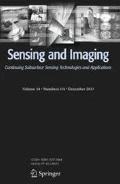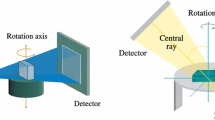Abstract
In practice, computed tomography and computed laminography applications suffer from incomplete data. In particular, when inspecting large objects with extremely different diameters in longitudinal and transversal directions or when high resolution reconstructions are desired, the physical conditions of the scanning system lead to restricted data and truncated projections, also known as the interior or region-of-interest (ROI) problem. To recover the searched-for density function of the inspected object, we derive a semi-discrete model of the ROI problem that inherently allows the incorporation of geometrical prior information in an abstract Hilbert space setting for bounded linear operators. Assuming that the attenuation inside the object is approximately constant, as for fibre reinforced plastics parts or homogeneous objects where one is interested in locating defects like cracks or porosities, we apply the semi-discrete Landweber–Kaczmarz method to recover the inner structure of the object inside the ROI from the measured data resulting in a semi-discrete iteration method. Finally, numerical experiments for three-dimensional tomographic applications with both an inherent restricted source and ROI problem are provided to verify the proposed method for the ROI reconstruction.








Similar content being viewed by others
References
Maisl, M., Porsch, F., & Schorr, C. (2010). Computed laminography for X-ray Inspection of Lightweight Constructions. In International symposium on NDT in aerospace, Berlin.
Tuy, H. K. (1983). An inversion formula for cone-beam reconstruction. SIAM Journal on Applied Mathematics, 43(3), 546–552.
Natterer, F., & Wübbeling, F. (2001). Mathematical methods in image reconstruction. Philadelphia: SIAM.
Katsevich, A. (2003). A general scheme for constructing inversion algorithms for cone beam CT. International Journal of Mathematics and Mathematical Sciences, 2003(21), 1305–1321.
Louis, A. K. (2016). Exact cone beam reconstruction formulae for functions and their gradients for spherical and flat detectors. Inverse Problems, 32(11), 115005.
Grangeat, P. (1991). Mathematical framework of cone beam 3D reconstruction via the first derivative of the Radon transform. In G. T. Herman, A. K. Louis, & F. Natterer (Eds.), Mathematical Methods in Tomography (pp. 66–97). New York: Springer. (Lecture Notes in Mathematics).
Feldkamp, L. A., Davis, L. C., & Kress, J. W. (1984). Practical cone-beam algorithm. Journal of the Optical Society of America, 1(6), 612–619.
Louis, A. K. (2003). Filter design in three-dimensional cone beam tomography: Circular scanning geometry. Inverse Problems, 19(6), S31.
Louis, A. K., Weber, T., & Theis, D. (2008). Computing reconstruction kernels for circular 3D cone beam tomography. IEEE Transactions on Medical Imaging, 27(7), 880–886.
Gordon, R., Bender, R., & Herman, G. T. (1970). Algebraic reconstruction techniques (ART) for three-dimensional electron microscopy and X-ray photography. Journal of Theoretical Biology, 29, 471–481.
Andersen, A. H., & Kak, A. C. (1984). Simultaneous algebraic reconstruction technique (SART): A superior implementation of the ART algorithm. Ultrasonic Imaging, 6(1), 81–94.
Clackdoyle, R., & Defrise, M. (2010). Tomographic reconstruction in the 21st century. IEEE Signal Processing Magazine, 27(4), 60–80.
Louis, A. K., & Rieder, A. (1989). Incomplete data problems in X-ray computerized tomography. Numerische Mathematik, 56(4), 371–383.
Noo, F., Clackdoyle, R., & Pack, J. D. (2004). A two-step Hilbert transform method for 2D image reconstruction. Physics in Medicine and Biology, 49(17), 3903.
Zou, Y., Pan, X., & Sidky, E. Y. (2005). Image reconstruction in regions-of-interest from truncated projections in a reduced fan-beam scan. Physics in Medicine and Biology, 50(1), 13.
Defrise, M., Noo, F., Clackdoyle, R., & Kudo, H. (2006). Truncated Hilbert transform and image reconstruction from limited tomographic data. Inverse Problems, 22(3), 1037.
Courdurier, M., Noo, F., Defrise, M., & Kudo, H. (2008). Solving the interior problem of computed tomography using a priori knowledge. Inverse Problems, 24(6), 065001.
Kudo, H., Courdurier, M., Noo, F., & Defrise, M. (2008). Tiny a priori knowledge solves the interior problem in computed tomography. Physics in Medicine and Biology, 53(9), 3903.
Yu, H., Ye, Y., & Wang, G. (2008). Interior reconstruction using the truncated Hilbert transform via singular value decomposition. Journal of X-Ray Science and Technology, 16(4), 243–251.
Yu, L., Zou, Y., Sidky, E. Y., Pelizzari, C. A., Munro, P., & Pan, X. (2006). Region of interest reconstruction from truncated data in circular cone-beam CT. IEEE Transactions on Medical Imaging, 25(7), 869–881.
Sidky, E. Y., Kao, C.-M., & Pan, X. (2006). Accurate image reconstruction from few views and limited angle data in divergent beam CT. Journal of X-Ray Science and Technology, 14(2), 119–139.
Zhang, B., & Zeng, G. L. (2007). Two-dimensional iterative region-of-interest (ROI) reconstruction from truncated projection data. Medical Physics, 34, 935–944.
Vogelgesang, J., & Schorr, C. (2016). A semi-discrete Landweber–Kaczmarz method for cone beam tomography and laminography exploiting geometric prior information. Sensing and Imaging, 17(17), 1–20.
Kowar, R., & Scherzer, O. (2002). Convergence analysis of a Landwerber–Kaczmarz method for solving nonlinear ill-posed problems. In V. G. Romanov, S. I. Kabanikhin, Yu E Anikonov, & A. L. Bukhgeim (Eds.), Ill-Posed and Inverse Problems (pp. 253–270). Utrecht: VSP.
Yosida, K. (1995). Functional analysis. Classics in mathematics. Berlin: Springer.
Hamaker, C., Smith, K. T., Solmon, D. C., & Wagner, S. L. (1980). The divergent beam X-ray transform. Rocky Mountain Journal of Mathematics, 10(1), 253–283.
Schorr, C., Dörr, L., & Maisl, M. (2015). Applying a priori information to computed laminography. In Proceedings of digital industrial radiology and computed tomography (DIR 2015).
Acknowledgements
The work of the authors was partially supported by Deutsche Forschungsgemeinschaft (DFG) under Grant LO 310/13-1, by the Sino-German Center for Research Promotion (SGC) under Grant GZ 1025 and the Bundesministerium für Bildung und Forschung (BMBF) project IPro (#20H1309B).
Author information
Authors and Affiliations
Corresponding author
Additional information
This article is part of the Topical Collection on Recent Developments in Sensing and Imaging.
Rights and permissions
About this article
Cite this article
Vogelgesang, J., Schorr, C. Iterative Region-of-Interest Reconstruction from Limited Data Using Prior Information. Sens Imaging 18, 16 (2017). https://doi.org/10.1007/s11220-017-0165-8
Received:
Revised:
Published:
DOI: https://doi.org/10.1007/s11220-017-0165-8




